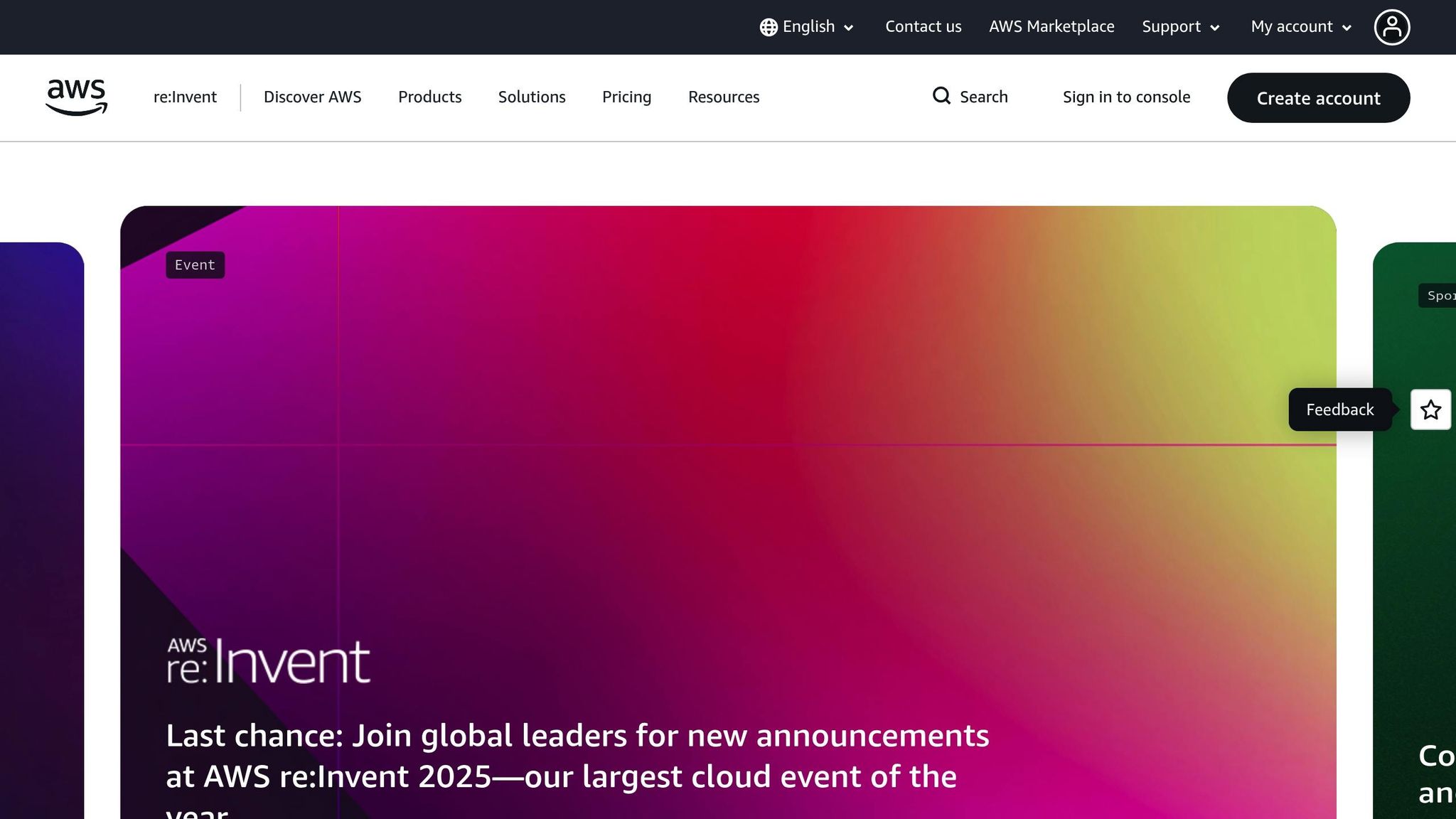Ultimate Guide to Reserved Instance Planning
Learn how UK SMBs can optimise AWS costs with Reserved Instances, balancing savings and flexibility for predictable workloads.

AWS Reserved Instances (RIs) offer businesses a way to save up to 72% on cloud costs by committing to specific EC2 instance usage for one or three years. For UK small and medium-sized businesses (SMBs) with predictable workloads, RIs can simplify budgeting and reduce AWS expenses. Here's how:
- Key Benefits: Lower costs, predictable pricing, and efficient resource allocation for steady workloads like databases or web servers.
- Types of RIs: Standard (highest savings, less flexibility), Convertible (lower savings, more flexibility), and Scheduled (time-specific use).
- Payment Options: All Upfront (maximum savings), Partial Upfront (split payments), and No Upfront (monthly payments, lowest savings).
- Planning Tips: Use tools like AWS Cost Explorer to analyse usage, start with conservative commitments, and consider a mix of RIs, On-Demand, and Spot Instances for cost efficiency.
Savings Plans and Reserved Instances - What purchase strategy is right for you? | AWS Events

Types of Reserved Instances and Payment Options
AWS offers three types of Reserved Instances (RIs) designed to cater to a variety of workloads. For UK small and medium-sized businesses (SMBs), choosing the right type and payment plan is key to balancing cost savings with operational needs.
Standard, Convertible, and Scheduled Reserved Instances
Standard RIs provide up to 72% savings and are best suited for workloads that remain steady and predictable over time. These are ideal for businesses with consistent resource demands, such as a Birmingham-based accounting firm running database operations. While Standard RIs offer the highest savings, they come with limited flexibility. You can make certain adjustments, like changing the Availability Zone within the same region or splitting larger instances into smaller ones, but you cannot exchange them for different instance families.
Convertible RIs, with savings of up to 66%, offer more flexibility. Businesses can switch between instance families, operating systems, or tenancy types during the term. This makes them perfect for SMBs experiencing growth or shifting requirements. For example, a fintech startup in London might begin with smaller instances and later scale up to more robust configurations without losing the benefits of their RI.
Scheduled RIs are tailored for workloads that follow predictable time patterns. These RIs allow businesses to reserve capacity for specific time slots - daily, weekly, or monthly. They’re an excellent choice for tasks like batch processing or seasonal data analysis. For instance, a Manchester e-commerce company might use Scheduled RIs for nightly inventory updates or weekly sales reports, ensuring these tasks run efficiently during off-peak hours.
| RI Type | Maximum Discount | Flexibility Level | Best For | Volume Discount Eligible |
|---|---|---|---|---|
| Standard | Up to 72% | Low (limited modifications) | Stable, predictable workloads | Yes |
| Convertible | Up to 66% | High (family, OS, tenancy changes) | Evolving or growing infrastructure | No (counts towards threshold) |
| Scheduled | Varies by usage | Time-based only | Recurring, scheduled tasks | No |
Once you’ve identified the RI type that aligns with your workload, the next step is selecting a payment plan that suits your financial strategy.
Payment Options: All Upfront, Partial Upfront, and No Upfront
Beyond choosing the RI type, UK SMBs need to consider payment options to optimise savings while managing cash flow effectively. The right payment model depends on your financial priorities and available resources.
All Upfront payments offer the largest savings by requiring the full amount to be paid at the time of purchase. This option is ideal for businesses with strong cash reserves looking to minimise long-term AWS costs and simplify their budgeting by removing monthly payments.
Partial Upfront provides a middle ground, requiring a smaller initial payment followed by discounted monthly charges throughout the term. For example, a growing software company in Bristol might choose this option to benefit from reduced monthly costs while keeping some cash on hand for other investments.
No Upfront spreads the payment evenly across monthly instalments with no initial outlay. While it offers the smallest discount, it’s a practical choice for businesses with limited capital or uncertain future needs. A Glasgow-based startup with tight cash flow might opt for this model to gain access to RI benefits without straining their finances.
Volume discounts add another layer of savings for businesses purchasing large numbers of Standard RIs. If the total value of active RIs in a region exceeds certain thresholds, additional savings kick in. For purchases between £400,000 and £3,200,000, a 5% discount applies, while purchases between £3,200,000 and £8,000,000 receive a 10% discount. These discounts apply to both upfront payments and hourly fees for future RI purchases.
When selecting a payment option, businesses should align their choice with financial goals and growth plans. Considering VAT implications and timing payments to fit within your fiscal year can further improve cash flow and tax efficiency.
How to Plan Reserved Instances Effectively
Planning Reserved Instances (RIs) effectively involves a thoughtful approach that balances cost savings with the need for operational flexibility. UK small and medium-sized businesses (SMBs) that carefully evaluate their workloads, plan their capacity needs, and understand how to adjust reservations can make substantial savings while avoiding overcommitment.
Assessing Workloads for Reserved Instances
The first step is identifying workloads that benefit most from reserved capacity. RIs work best for workloads with predictable, steady, and continuous usage. Core business functions like databases, web servers, payroll systems, and enterprise applications often exhibit consistent resource consumption, making them excellent candidates for RIs.
Take payroll systems, for example. These systems have steady resource demands regardless of seasonal fluctuations, making them an ideal fit for Standard RIs, which can offer up to a 72% discount.
AWS Cost Explorer is a valuable tool for analysing past resource consumption. It highlights which instances run consistently and which have variable usage. This data helps businesses decide which workloads are suited for RIs and which are better handled with On-Demand or Spot instances.
Before committing to RIs, it's essential to right-size existing instances. Many businesses discover they've been over-provisioning resources. Adjusting these instances ensures that the reserved capacity matches optimised usage rather than inflated requirements.
However, not all workloads are suitable for RIs. Applications with unpredictable demand, development environments that run sporadically, or systems with uncertain lifespans are better suited to On-Demand pricing. While On-Demand costs more per hour, it offers the flexibility needed for these scenarios.
Once suitable workloads are identified, UK SMBs can forecast their capacity needs with greater accuracy.
Capacity Planning for SMBs
Good capacity planning strikes a balance between current requirements and realistic growth projections. UK SMBs should start with conservative RI commitments and expand as they gain confidence in their usage patterns rather than overestimating future needs.
Tools like the AWS Pricing Calculator are invaluable for simulating growth scenarios. Regular reviews - ideally quarterly - allow businesses to adjust their reserved capacity as usage evolves. This approach aligns well with UK financial planning cycles, such as the April-March fiscal year.
Seasonal patterns also play a role in capacity planning. For instance, a Manchester-based e-commerce business might see a predictable traffic surge during the Christmas shopping season but maintain consistent usage the rest of the year. In such cases, Standard RIs can cover baseline needs, while On-Demand instances handle peak periods, ensuring both cost efficiency and performance.
Growth projections should factor in future product launches, customer acquisition plans, and infrastructure changes. However, businesses should avoid overcomplicating these forecasts. For workloads with uncertain growth, shorter-term RIs or Convertible RIs offer greater flexibility, sacrificing some savings for adaptability.
Modifying and Reselling Reserved Instances
Once capacity needs are set, flexibility becomes key as business demands evolve. AWS offers various options to modify RIs, ensuring that businesses can adapt without losing their investment.
Standard RIs can be adjusted by changing the instance size, Availability Zone, or networking type within the same region. These modifications allow businesses to adapt to shifting infrastructure needs while maintaining cost savings. For example, a software company might split larger RIs into smaller ones to distribute workloads or combine smaller RIs into larger configurations during scaling phases.
Convertible RIs provide even greater flexibility, allowing businesses to exchange them for other Convertible RIs of equal or higher value. This feature is particularly useful for companies undergoing architectural changes, such as upgrading to newer instance families or switching operating systems as application needs evolve.
In cases where RIs are no longer required, the AWS Reserved Instance Marketplace offers a way to sell surplus Standard RIs. Listings with longer terms and competitive pricing tend to attract buyers more quickly. However, only Standard RIs purchased directly from AWS qualify for resale on the marketplace, making this an important consideration when planning RI purchases.
For more detailed advice, check out AWS Optimization Tips, Costs & Best Practices for Small and Medium sized business. This resource provides SMB-specific guidance, covering everything from architectural strategies to automation techniques that complement effective RI planning.
Cost Optimisation and Best Practices
When it comes to managing costs with Reserved Instances, the key lies in blending pricing strategies, keeping a close eye on usage patterns, and tailoring approaches to local business needs. For UK-based small and medium-sized businesses (SMBs), combining multiple pricing models while addressing local requirements can lead to significant savings without compromising operational agility.
Combining Reserved Instances with Other Pricing Models
A well-rounded cost strategy involves leveraging Reserved Instances (RIs) for predictable workloads and complementing them with On-Demand and Spot Instances for fluctuating demands. Take, for instance, a London-based e-commerce SMB. They reserved RIs for their core web servers, handled Black Friday traffic surges with On-Demand Instances, and ran analytics jobs on Spot Instances. By conducting quarterly monitoring and right-sizing their resources, they managed to cut their annual AWS spend by 40% while improving forecasting accuracy. This demonstrates how integrating various pricing models can drive efficiency.
Spot Instances can slash costs by up to 90% compared to On-Demand pricing, making them a great choice for batch processing, development, and fault-tolerant applications. To maximise savings, it’s crucial to match workloads to the right pricing model. For instance, database servers and application backends, which tend to have steady usage, are ideal candidates for Standard RIs. On the other hand, development environments and batch jobs can take advantage of Spot Instances. For traffic spikes during promotional events, On-Demand Instances offer the flexibility needed to scale quickly.
Monitoring and Right-Sizing Reserved Instances
Keeping a close watch on usage is essential to avoid paying for unused capacity. Right-sizing AWS instances has the potential to lower costs by up to 36%, making it a vital part of any optimisation strategy. Regularly reviewing metrics like RI utilisation rates, instance performance, and capacity trends can help ensure reserved resources align with actual demand. Many businesses discover they’re running oversized instances, so downsizing before committing to new reservations can prevent unnecessary expenses.
AWS Budget Reports are a handy tool for UK SMBs, offering clear insights into spending patterns and RI utilisation. They also allow businesses to set alerts for when spending approaches predefined limits. Aligning right-sizing reviews with business planning cycles can uncover opportunities to consolidate workloads or switch to instance families that offer better price-to-performance ratios. These practices not only cut costs but also lay the groundwork for effective budgeting tailored to UK operations.
UK-Specific Best Practices
To refine cost management further, UK SMBs should adapt their strategies to local financial practices. Budgeting in pounds sterling and keeping an eye on exchange rate fluctuations is essential, especially for long-term RI commitments. Although AWS bills in US dollars, converting expenses into GBP ensures accurate financial planning - particularly for three-year commitments.
Using UK date formats (DD/MM/YYYY) in financial reports and aligning RI purchases with the UK fiscal year (April to March) can help maintain clarity and compliance with local accounting standards. Additionally, businesses with larger RI commitments can benefit from volume discounts, while the Reserved Instance Marketplace provides flexibility by allowing the resale of Standard RIs when business needs evolve - a feature not available for Convertible RIs.
Regional factors also play a role. Pricing in the London (eu-west-2) region may differ from other European regions, and data residency requirements can influence where RIs are purchased. By understanding these nuances, UK businesses can strike the right balance between cost efficiency and regulatory compliance.
For more detailed advice on cost optimisation, architecture planning, and automation strategies, check out AWS Optimization Tips, Costs & Best Practices for Small and Medium sized business.
Common Mistakes and How to Avoid Them
Small and medium-sized businesses (SMBs) often face challenges when planning Reserved Instances (RIs). Missteps in this area can lead to unnecessary expenses and operational headaches. Let’s dive into some common mistakes and how you can steer clear of them.
Overcommitting to Reserved Instances
While Standard Reserved Instances can deliver significant savings, they can also backfire if you overestimate your needs. This often happens when businesses rely on overly optimistic growth projections or fail to account for fluctuating workloads. If market conditions shift, unused RIs can quickly become a financial burden.
Take the example of a London-based fintech company. They invested heavily in 3-year Standard RIs based on ambitious growth forecasts. When their compute requirements dropped due to changing market conditions, they were left with excess capacity and wasted spend.
To avoid this, base your decisions on historical usage data rather than hopeful projections. If you're still figuring out your baseline requirements, start with shorter-term commitments. A 1-year RI might not offer the same discounts as a 3-year option, but it provides the flexibility to adjust as your needs become clearer.
Another option is Convertible Reserved Instances, which offer up to 66% savings and allow adjustments to instance families, operating systems, and tenancy as your requirements evolve. This flexibility can help you adapt without locking yourself into rigid commitments.
Failing to Monitor Usage Regularly
One of the most common mistakes is treating RI purchases as a "set and forget" strategy. This approach can waste 10–30% of your cloud spend annually. Without regular monitoring, you miss opportunities to optimise your RI portfolio, leaving you with resources that no longer align with your workloads.
For instance, right-sizing AWS instances can cut costs by up to 36%. Regularly reviewing your usage helps identify oversized instances and prevents you from locking into inefficient configurations.
Tools like AWS Cost Explorer can provide detailed insights into your RI utilisation, coverage, and potential areas for optimisation. Setting up AWS Budget Reports is another smart move, as it allows you to receive alerts when spending approaches predefined limits. For UK businesses, these tools can track expenses in pounds sterling, helping maintain financial control.
Establishing a monthly review process is essential. Focus on metrics such as RI utilisation percentage, unused RI hours, cost savings compared to On-Demand pricing, and quarterly usage trends. Formatting this data in GBP (£) and UK date formats (DD/MM/YYYY) ensures clarity and consistency. Regular reviews not only optimise costs but also help you stay agile as your business evolves.
Ignoring Business Changes and Growth
Business needs rarely stay the same. Product launches, seasonal trends, and market expansions can all disrupt your initial RI strategy. Many SMBs fail to adjust their commitments accordingly, leading to mismatched capacity and unnecessary costs.
For instance, a seasonal business might base its RI purchases on peak Christmas trading volumes, only to find itself overpaying during quieter months. On the flip side, rapid growth can outstrip existing RI capacity, forcing reliance on more expensive On-Demand instances.
To address this, reassess your RI portfolio regularly, ideally aligning it with your business planning cycles. Major changes - like launching a new product or entering a new market - should trigger a review of your commitments to ensure they still match your needs.
A balanced strategy is key. Combine Reserved Instances for predictable workloads with On-Demand capacity for variable demands. This hybrid approach keeps costs under control while accommodating growth. For workloads with uncertain trajectories, Convertible RIs provide the flexibility to adjust configurations as your needs evolve.
| Common Mistake | Impact | Prevention Strategy |
|---|---|---|
| Overcommitting to RIs | Unused capacity, wasted spend | Start cautiously, use historical data, and consider Convertible RIs |
| Poor usage monitoring | 10–30% wasted spend annually | Conduct monthly reviews, leverage AWS Cost Explorer, and set automated alerts |
| Ignoring business changes | Mismatched capacity, inefficient costs | Regularly reassess, use the RI Marketplace, and adopt a hybrid pricing strategy |
Avoid the temptation to overcommit just to secure volume discounts. The small additional savings often don’t outweigh the losses from unused capacity when your business needs shift.
These mistakes are often interlinked. Overcommitting can result from insufficient monitoring, while neglecting to adapt to business changes can amplify the problem. By tackling these areas systematically, SMBs in the UK can make the most of Reserved Instances while maintaining the flexibility needed for long-term success.
Conclusion
For UK small and medium-sized businesses (SMBs), planning Reserved Instances (RIs) is a smart way to manage AWS costs while maintaining strong operational performance. With substantial savings over On-Demand pricing, RIs provide a predictable monthly expense in pounds sterling and ensure capacity for essential workloads.
To get the most out of RIs, it’s crucial to understand your workload patterns and choose the right mix of RI types and payment options. Standard RIs are ideal for steady workloads, offering the highest savings, while Convertible RIs give you the flexibility to adjust as your business needs change. Together, these options can significantly enhance your financial efficiency when paired with thoughtful planning.
Monitoring is another key piece of the puzzle. Regularly tracking RI usage, cost savings, and coverage ensures your strategy stays aligned with your business goals. Tools like AWS Cost Explorer can help you make informed decisions, especially when keeping track of costs in GBP and using UK-friendly date formats. This level of precision helps you strike the right balance between pricing models.
A hybrid pricing strategy - combining Reserved Instances with On-Demand and Spot Instances - can provide the best of both worlds. This approach allows you to manage predictable workloads with RIs while handling sudden demand spikes with the flexibility of On-Demand and Spot Instances. It’s a practical way to control costs without compromising on performance.
Avoiding common pitfalls is just as important. Overcommitting based on overly optimistic forecasts, neglecting regular usage reviews, or failing to adjust for changing business needs can quickly undermine the financial benefits of RIs. Starting with shorter-term commitments and scaling up as you gain confidence is a safer strategy for UK businesses.
For ongoing support and expert tips tailored to SMBs, resources like the AWS for SMBs blog offer valuable insights and actionable advice for navigating the AWS ecosystem.
Reserved Instance planning is not a one-off task - it’s an evolving process. By applying the strategies outlined here and conducting regular reviews, UK SMBs can unlock significant savings while building a scalable, future-ready cloud infrastructure to support long-term growth.
FAQs
How can small and medium-sized businesses in the UK choose the right type of Reserved Instance for their needs?
To select the right type of Reserved Instance, small and medium-sized businesses in the UK should carefully assess their workload needs, budget constraints, and long-term usage habits. Begin by evaluating how consistently your applications operate and whether their usage is predictable. For workloads that remain steady, a Standard Reserved Instance can offer substantial savings. However, if your requirements are likely to shift, Convertible Reserved Instances provide the flexibility to adapt.
Your payment approach is another key consideration. If your budget allows for upfront spending, the All Upfront payment option provides the largest discount. On the other hand, Partial Upfront or No Upfront plans spread the costs over time, making them more suitable for businesses with limited cash flow. By aligning your Reserved Instance choice with both your operational demands and financial strategy, you can achieve cost savings while maintaining efficiency.
What are the risks of overcommitting to Reserved Instances, and how can small businesses avoid them?
Overcommitting to Reserved Instances (RIs) can quickly become an expensive mistake if your actual usage falls short of what you anticipated. Since RIs typically involve upfront payments or long-term agreements, any unused capacity is essentially money wasted. On top of that, if your workload or business needs change, you might find yourself stuck with an RI setup that no longer fits.
To steer clear of these pitfalls, take the time to thoroughly analyse your usage patterns over a significant period. This will help you make more accurate forecasts. If your business values flexibility, consider shorter commitment periods or convertible RIs, which allow you to adjust configurations as needs shift. It's also a good idea to regularly review your RI portfolio to ensure it keeps pace with your business's changing demands. Tools like AWS Cost Explorer can be incredibly helpful for tracking usage and fine-tuning your RI strategy.
What is the AWS Reserved Instance Marketplace, and how can reselling unused Standard RIs benefit my business?
The AWS Reserved Instance (RI) Marketplace provides a platform for businesses to sell their unused Standard Reserved Instances to other AWS users. This gives organisations a chance to recoup costs from RIs they no longer need, offering a practical solution when their cloud usage or requirements shift.
For small and medium-sized businesses (SMBs), selling unused Standard RIs can be a smart way to manage costs. It transforms unused resources into financial returns, helping to stretch budgets further. On the flip side, buyers on the marketplace can often find RIs at reduced prices, creating a mutually beneficial arrangement for both parties.




